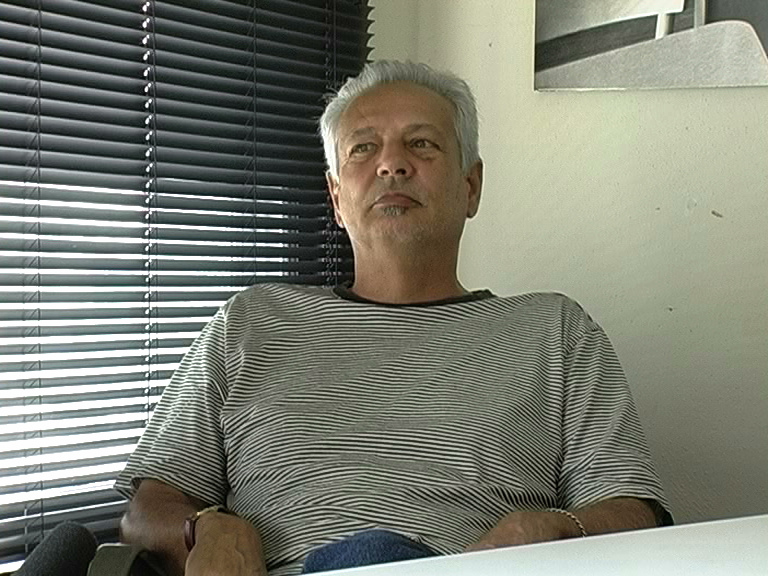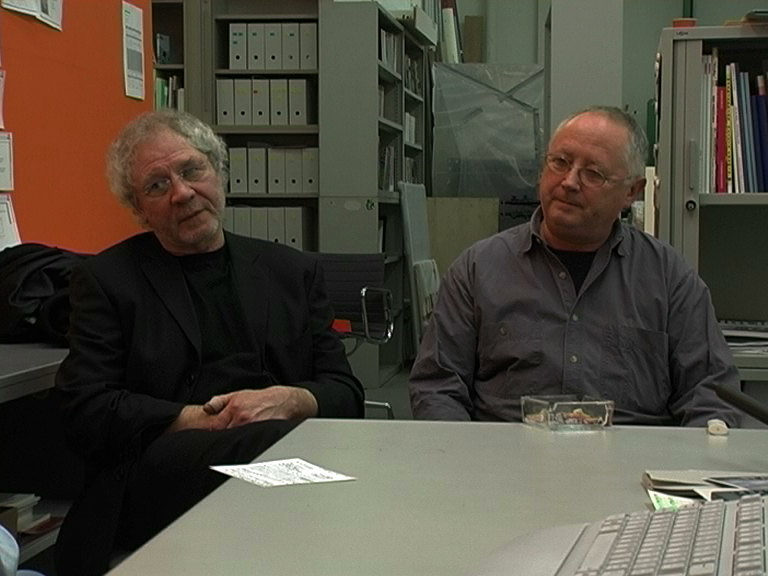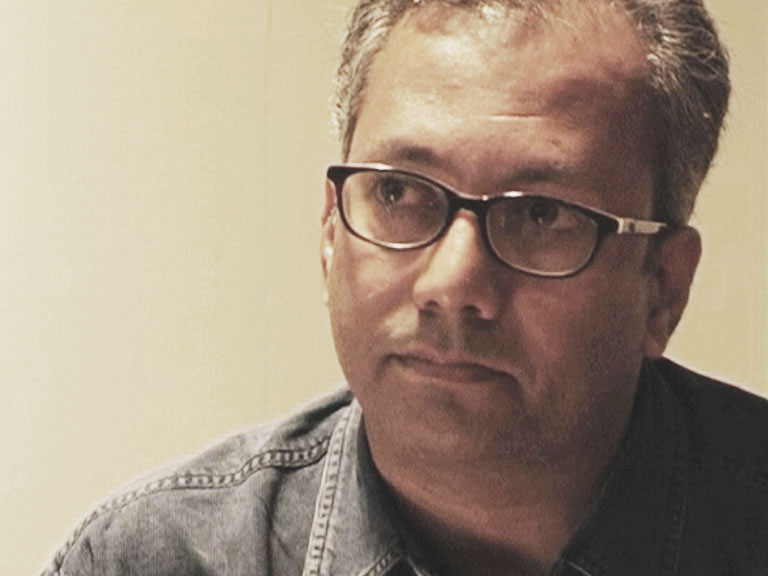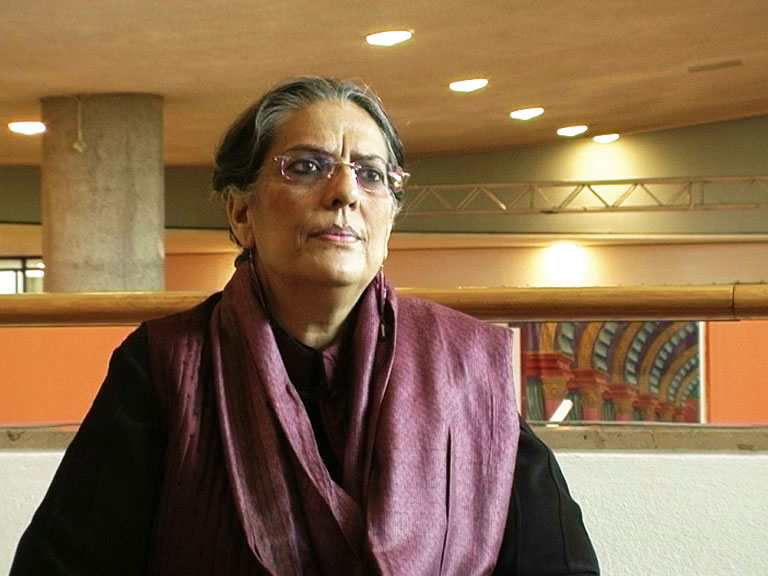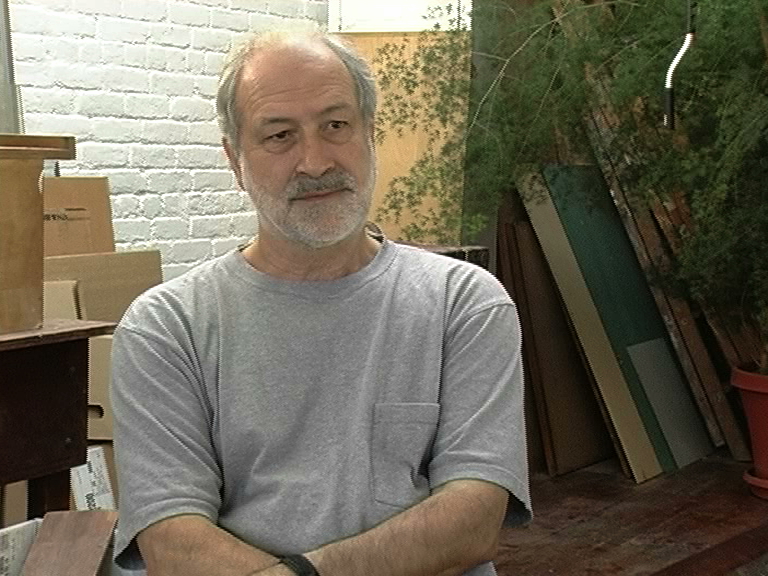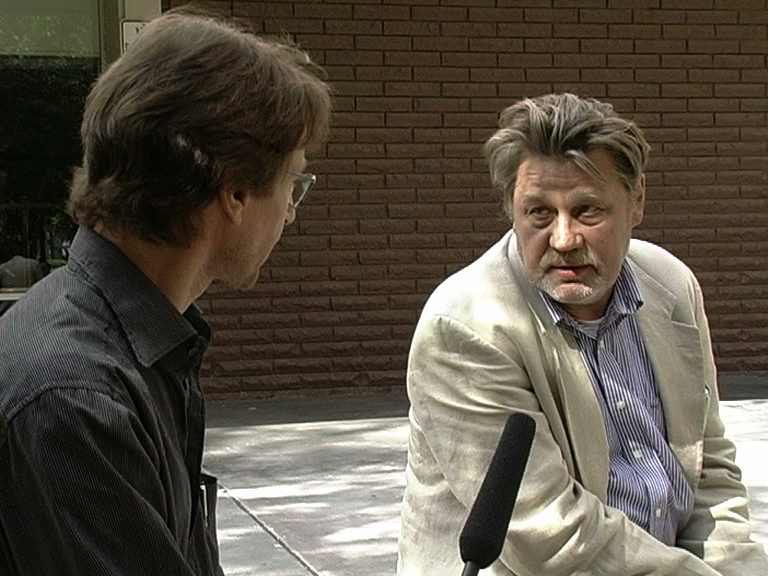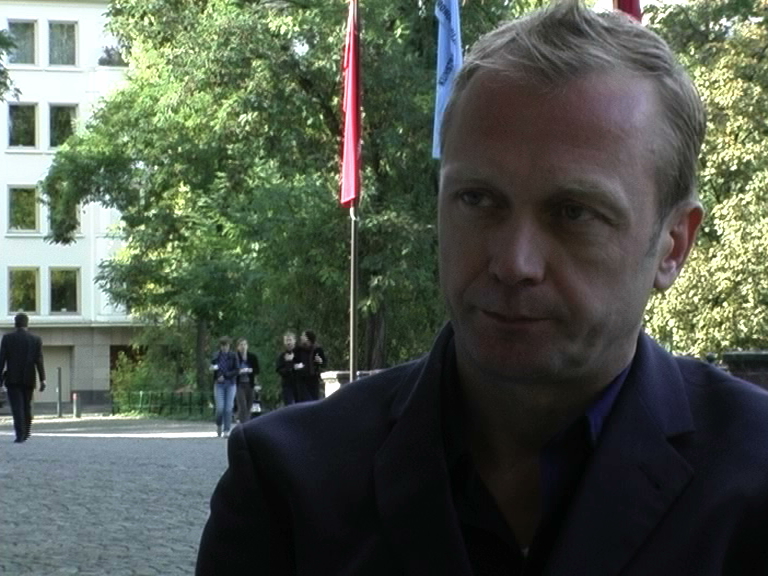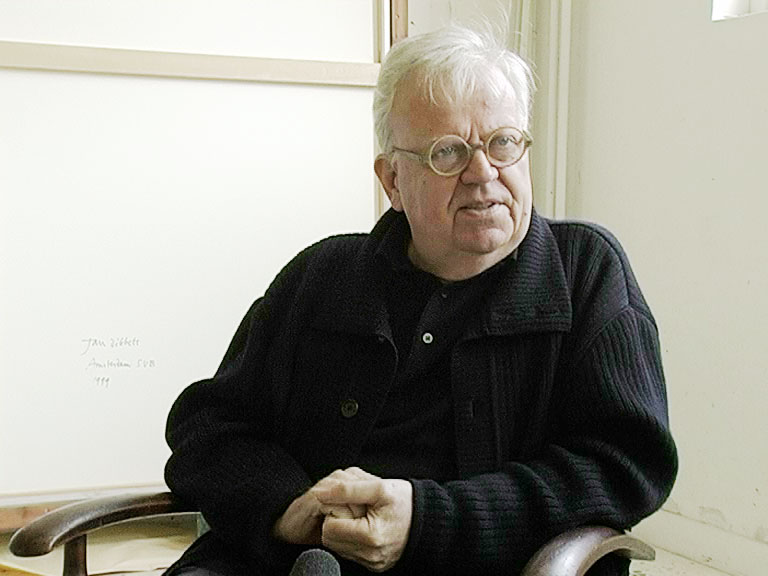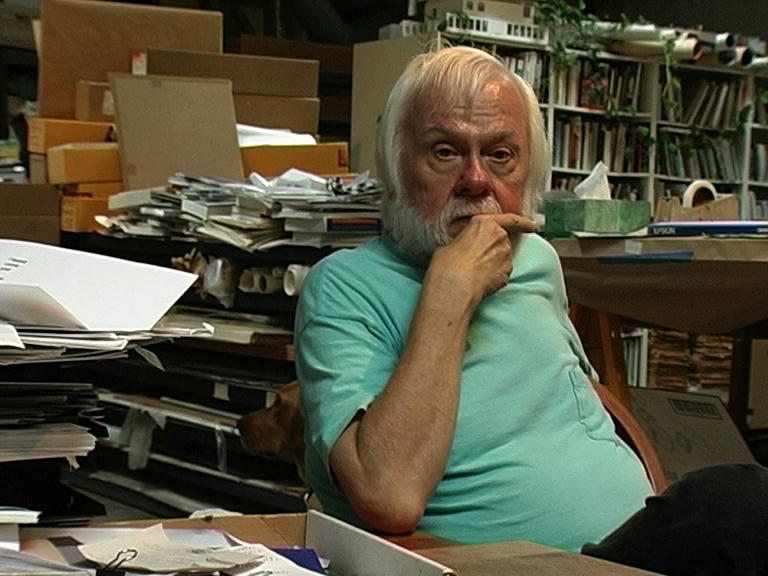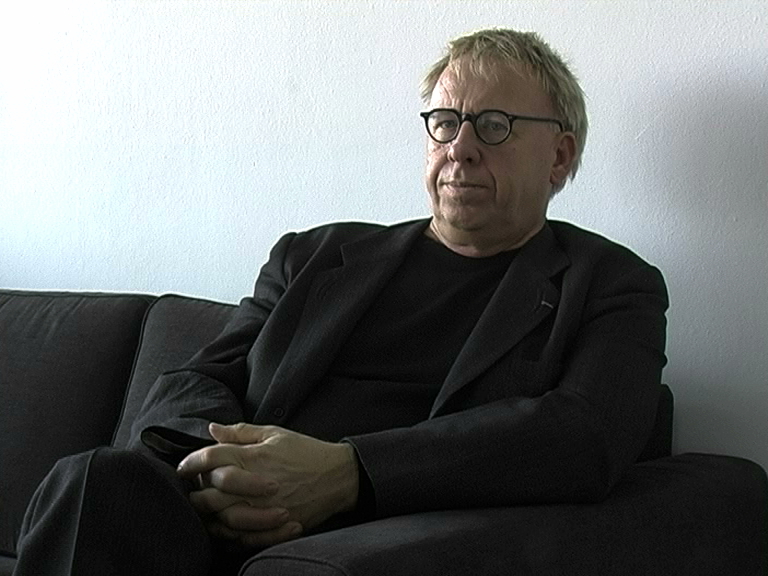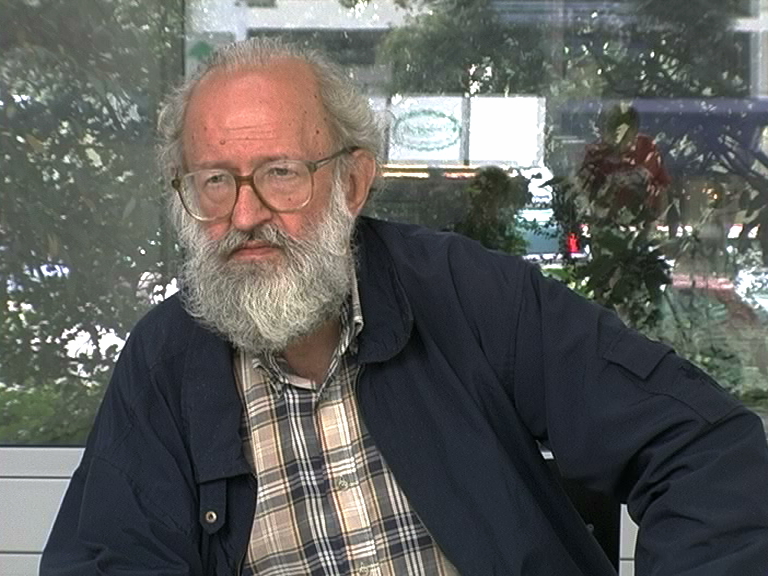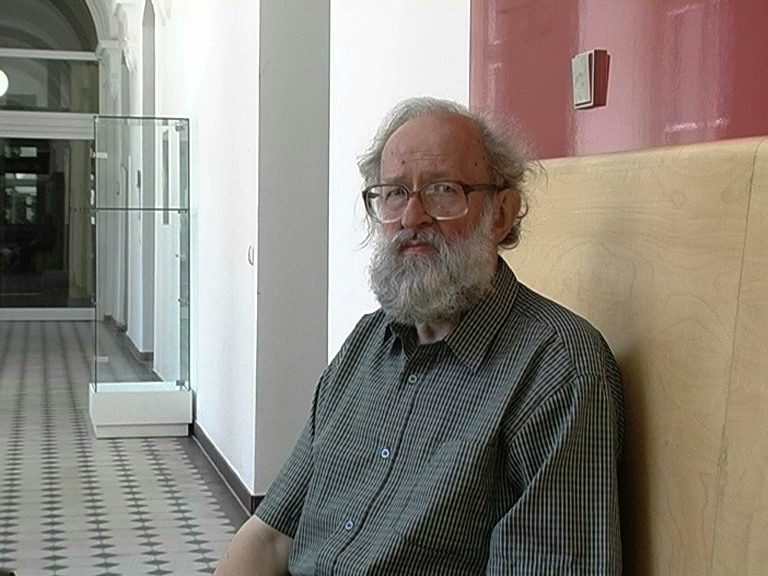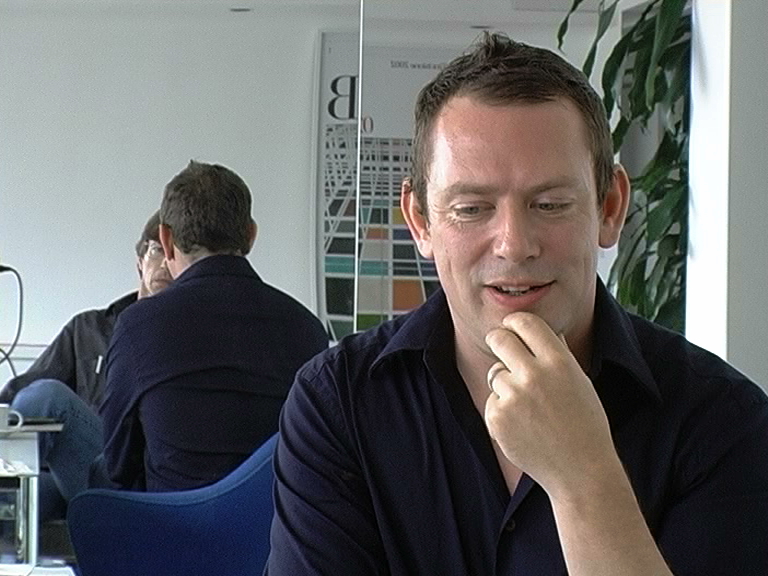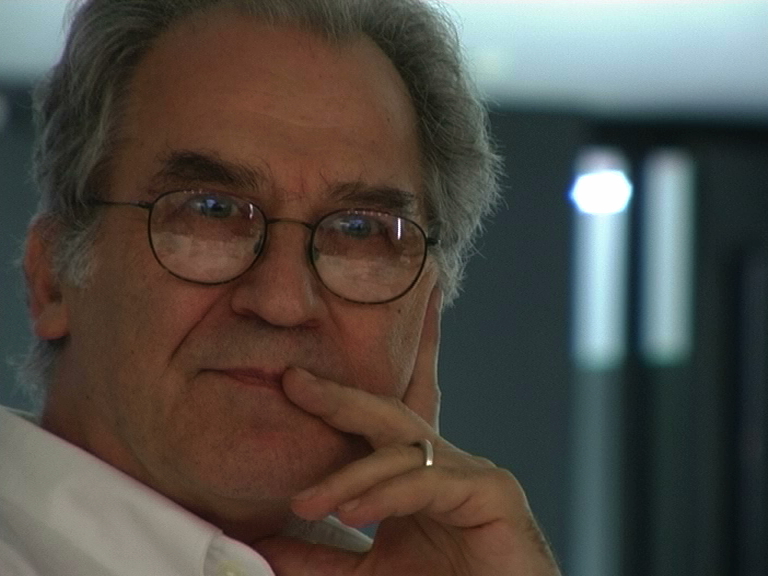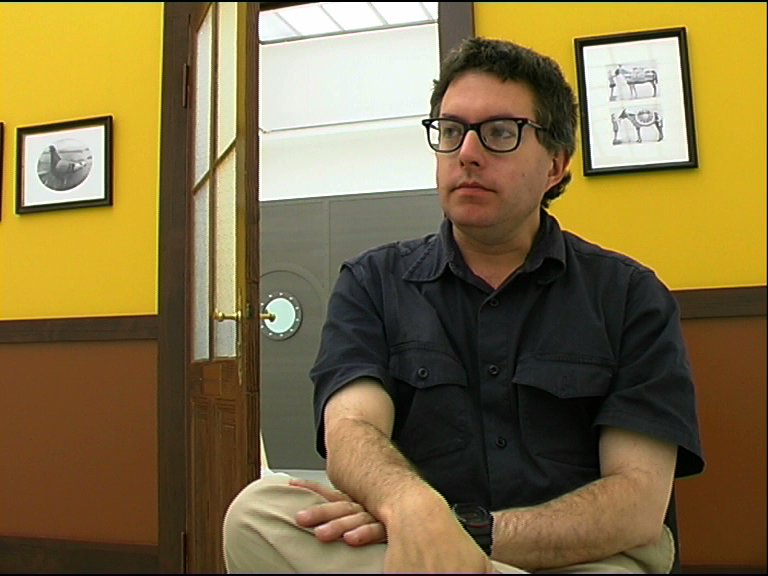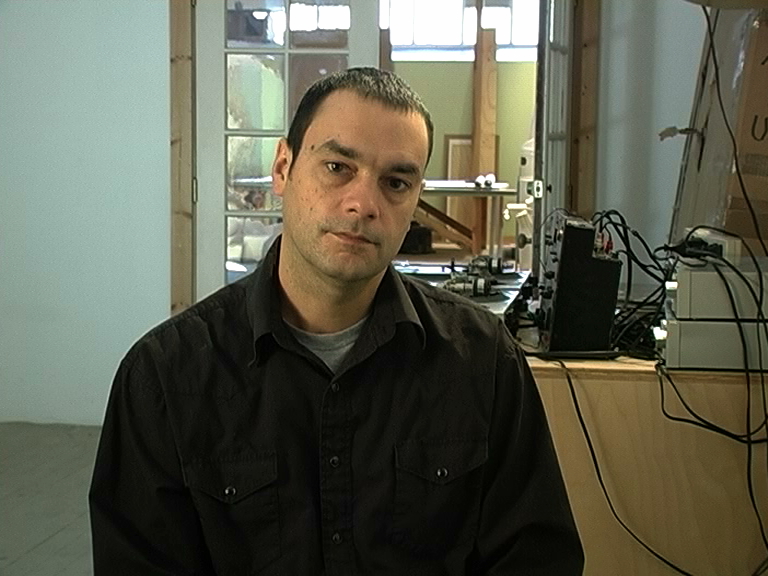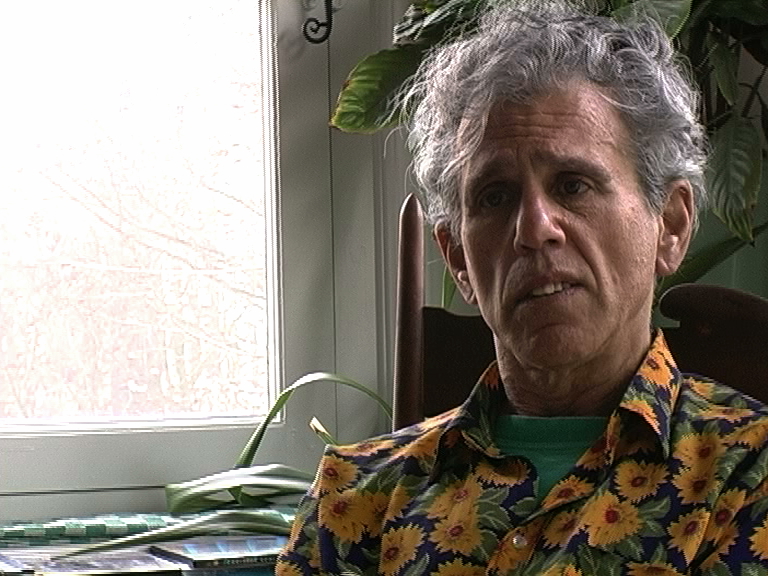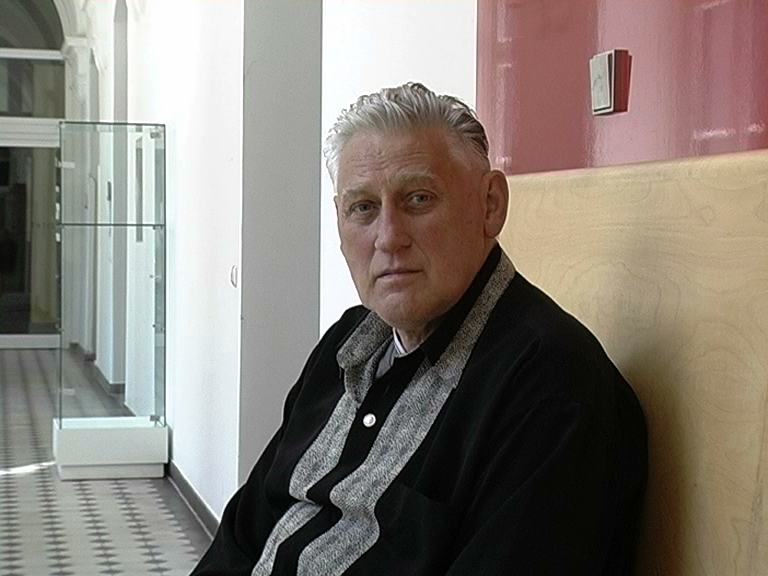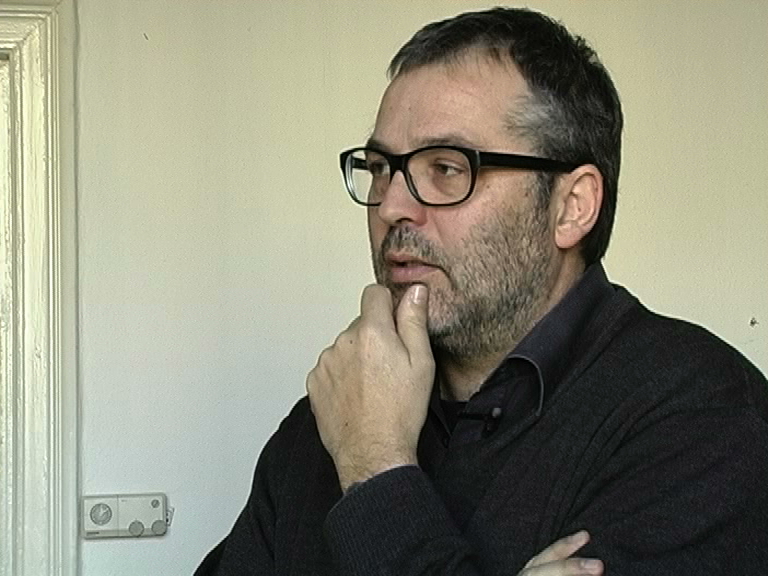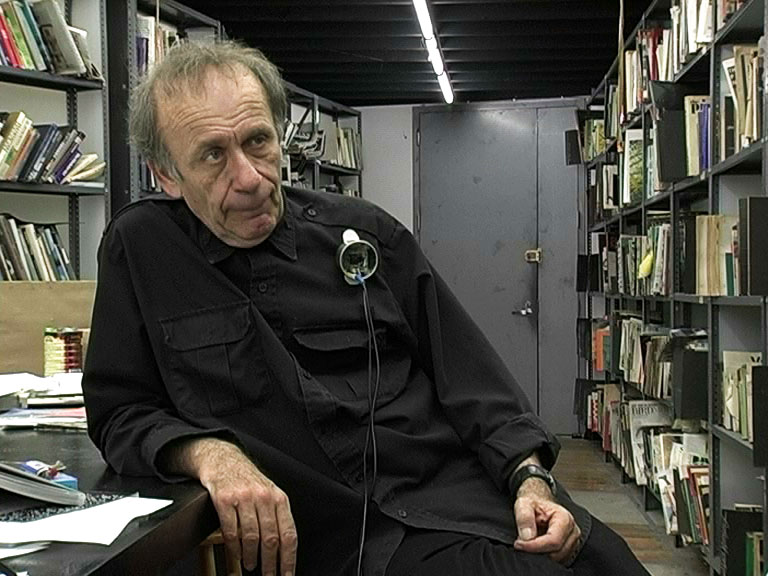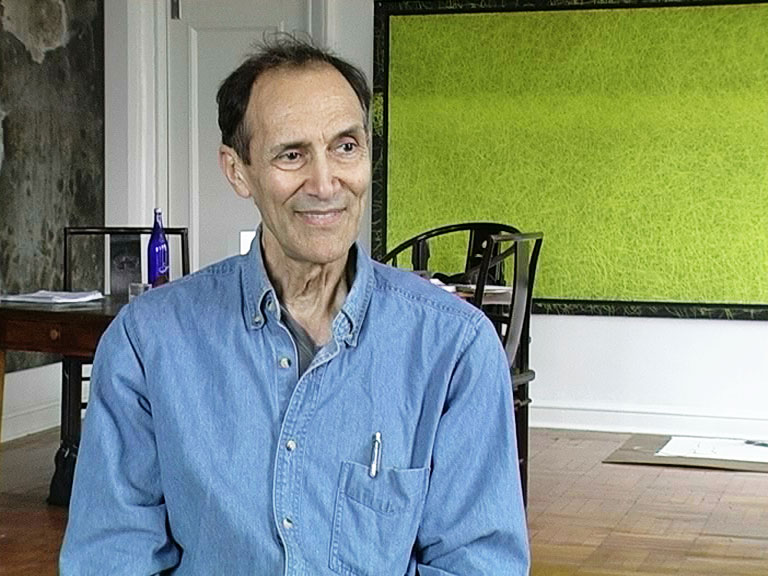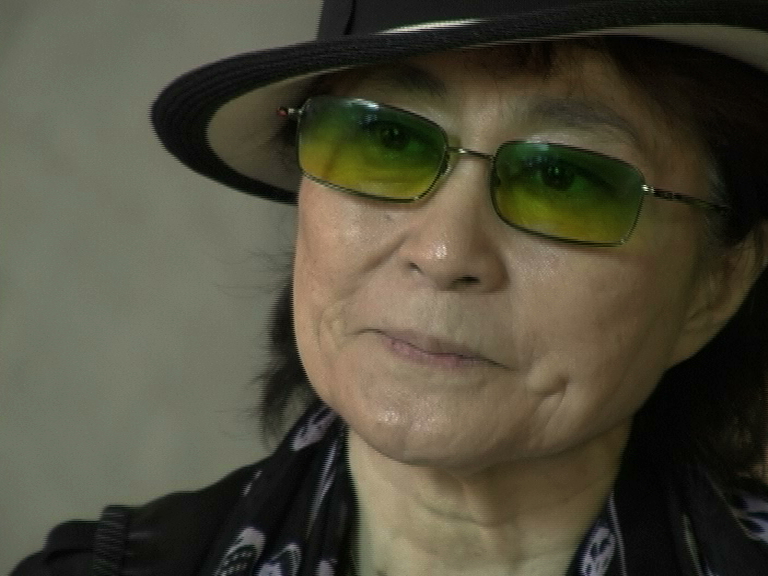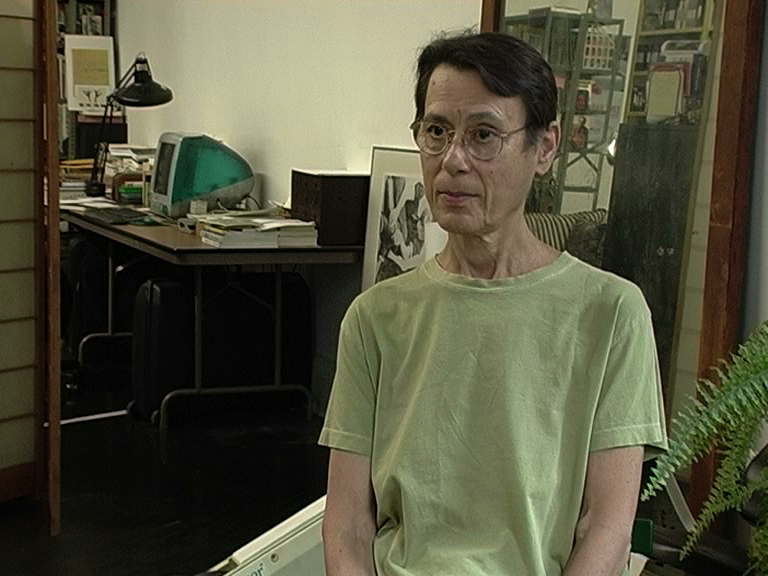M.B.: What I want to ask you: how are you going to edit this? Because the thing that I’m nervous about, what I’ve seen in some of these films is, I mean it seems you have two choices: one is just to present each person as a block, and the other is to create a conversation between the different people. And when you do that, there is some risk involved as to what your editorial position is and to what your favorites are. I mean which artist you are more interested in and who comes out looking good who comes out looking bad. And that to me becomes problematic.
S.R.: I understand. From my position, there are two strategies, media strategies. One will be to make…
M.B.: I want to stay out of those things. It’s really just another form of self-promotion. That these arguments about who did what first are really pointless. It’s just a way of certain artists of keeping their name in the foreground where perhaps their work is in the background. I’m willing to talk about my work, but I’m unwilling to talk about any other artists. OK?
S.R.: It’s up to you. It’s your choice.
M.B.: Well you must have some questions. I think that a tremendous amount of time has been wasted over the years with false claims, people making unverifiable claims. And then other people trying to refute those claims and creating situations, which are pointless to me. So that’s why I really want to stay away from. And I don’t want to be drawn into that, in the process of editing. “I did this first and I did that first and so and so and I did nothing first and I’m this and I’m that.“ Just please leave me out of that thing.
S.R.: My questions are not focusing in this direction. For me it’s much more interesting to have something for example the issue of the public or the reception. What kind of change in reception does Conceptual art mean in the 1960s, 70s, than you have maybe five or six different interesting statements you can put on the role.
M.B.: As long as we are on that level I’m willing to do it. But there are other people who’ve come to me with all of these questions, which I’m not going to answer. I don’t want to disappoint you, I don’t want to waste my time, as long as we’re clear about that then go ahead and ask me the questions.

S.R.: Let me just add one thing to the media strategy. The one thing is that the film will be one and half an hour and we will try to do something like an archive of all the usable material of the interviews, that is certainly around the reception of your works, your drawings and paintings and also your photographs are well known. And how do you see, if you have a historical view on the whole thing, how do you see the change of reception of your work? How did it start at the end of the 1960s, in the middle of the 60s when the Conceptual movement started – and after that?
M.B.: Well a couple of years ago, a young critic came to speak with me and he said, “How does it feel to have been part of the dominant discourse of the 60s?“ – to which I said, „You’ve got to be joking“ [laughs]. Because I couldn’t even pay the rent. The way in which history looks back on that time and chooses what it can use or what appears to be valuable in hindsight has almost nothing to do with the reception that it has at the time. So I mean I can say that besides other artists, nobody was interested in my work. And I was in New York for almost eight years before a gallery in New York represented me. The first reception of my work was in Germany, and the first one person exhibition I had was at the School of Visual Arts, which happened more or less by accident because I was a young teacher and the director of the gallery there asked me to organize a drawings exhibition for Christmas. And I thought she said a drawings exhibition to be on during Christmas. And she thought I was going to make a drawings exhibition about Christmas. When I brought in the material that I wanted to show – because at that time I was very interested in what I called what was “upstream” from the work, like the work in drawing, the thought-process, rather than the object, what lead to the object. When I showed her the things that were going at the show, which were little scraps of paper, people’s bills, Judd’s fabrication bill – she thought that was a joke. And she said, people don’t want to see this for Christmas; and of course we don’t have any money to frame it. With there being no money for framing I either had to give it up the exhibition or think of something else, and I didn’t want to tack the things on the wall with pins, so the school had just purchased a Xerox-machine which was a very new technology then. Because I taught in the art history department rather than the studio department, I had unlimited access to the Xerox-machine. You know to Xerox articles to give to the students for reading. So I had all these paintings xeroxed. And as they came out of the Xerox-machine they were in a nice perfect stack, it was already like a book. So I thought, rather than putting them on the wall I make them into a book. And just having one book didn’t seem like a very interesting idea. So I thought, well, I need more than one I make four, because four is the first non-prime number. And then I thought I put them on a table, but then I it seemed to me that it would be amusing to put them on stands, which would be a kind of pastiche of a Robert Morris sculpture. And a book is a volume, a sculpture is a volume, it just seemed to play out. Suddenly, there it was, it was an exhibition. Many artists attended the opening, but not one single review was written of the exhibition because––what could you say, what was it?––no-one understood, is it a book, is it an exhibition? The word “installation” didn’t exist, the word “Conceptual art” didn’t exist. The way one judged one‘s reception in those days was not by the mechanisms that exist now, which is generally a commercial gallery exhibitions, sales, museums––it was by the response of other artists. The fact that within six months of that show other artists started making book-exhibitions was the reception of the show, the ideas had entered the stream. That was the way one worked, one worked for the discourse with other artists.
S.R.: So if you say that was one of the first steps, would you say that in the beginning of the 1970s or a little bit earlier there was a bigger reception of this kind of work or was it still something like in art circles, small art circles?
M.B.: Well, probably it changed in 1969 when Szeemann organized the “attitude-form” show, that brought it to public attention. And then suddenly, out of nowhere, there were dealers, but again in my case mostly European dealers. The first dealer who came to visit me in the first person, who, I would say outside of my friends and other artists, took the work seriously, was Heiner Friedrich. He came to my studio in ‘67 for the first time; and then Konrad Fischer came very soon near after––but in both these cases because other artists had told them about me. Then the first commercial gallery show that I had was with Friedrich in Munich in 1969. But he had been interested in the work before Szeemann’s show, so I have to give him that credit, but it was the “attitude-form” show which brought institutional interest to the work. It was suddenly as if certain lines were being drawn that connected all of these things, which didn’t look alike, together and gave them a name. That’s the way the art world works––they look for an -ism, a name, to tie things together. And as an artist that’s both a negative and a positive. Because it levels out the definitions into a broad general category which generally doesn’t fit anybody’s work, but, because there is something that your work can share with that broad general category, it brings people around to look at. You have to take those two things together; and it happens to everyone, and then you start fighting with the name of the movement; as Judd hated “Minimalism”; I hate “Conceptualism”. But you’re stuck with it.

S.R.: One possibility or one option to work with this situation, with this context is––like you did––to write texts, essays. I read not long ago your critique of Lucy Lippard’s book “The Dematerialization of the Art Object from 1966 to 1972”. In this text you are coming up with a very harsh but also a very precise critique of her strategy to make this book and what she was historicizing in this book. When did you start to write in this kind of specific critical language about art, about art books?
M.B.: My writing career was a complete accident. [laughs] I had no interest in writing. But I found myself one day in 1965 without a job and without any money [laughs], with no prospects. And trying to think of something that I might be able to do to earn some money I thought, well, surely I could write those little reviews that appear in the back of art magazines. Judd had written for art magazines. Well I thought, they are sympathetic to artists, I would go in and try them so I went in and asked the editor for a job, and he asked me what experience I had, and I said: none. He found that amusing [laughs] for some reason, and he said: Ok, we’ll give you a tryout. Then he gave me a list of twenty-five shows to go and see and write reviews of anything that interested me and turned them in and he would decide. I turned them in, he didn’t say anything and the next month they appeared in the magazine. Now, I suppose in those days they were desperate for writers [laughs]. Suddenly I was a critic. In the beginning I was just doing these shows which were not terribly interesting or important. They were really, any gallery or even frame store that took an advertisement in the magazine, they would send a reviewer to see the show, and they knew it would pay $ 2,50 for every review. My rent at that time was $ 22 a month, so I could just get by if I reviewed all 30 shows [laughs]. They didn’t publish them all, but they would pay you $ 2,50 just for writing it, whether they’d published it or not. Then at a certain point after I’d been doing it for so many months there start to come along shows that I was interested in, and I asked if I can write about those shows, and then I was writing about those shows. And the first one that I did that got any attention was a review of the “Primary Structures” show. And that was a very important show at the Jewish Museum because it was something like the first Minimalist show. I wrote kind of a strong critique of that show in terms of mixing English sculptors like Anthony Caro and those people with people like Judd and Flavin, Morris and Andre. Suddenly I found that people were reading this and responding, and that there was a real audience for that. Then other people started asking me to write things. So pretty soon I was writing more than I ever intended. That was in terms of the critical things. But then in 1966, Smithson and I became friends and we embarked on this project, which was published in the fall issue of Arts Magazine, where we began to think about using the magazine as a primary site, rather than a secondary site. Instead of writing about something make the writing the thing itself. What we wanted to do is in a way camouflage the artwork and sneak it sort of like, under the radar of the system. So that instead of a reproduction of something, the article would be a reproduction as something. Without telling anybody, except friends, what we were doing, we did this article called “The Domain of the Great Bear”, which was an article about the planetarium. That was the other stream that writing took in my work. There was one stream that was critical and there was one that was the writing as art, as artwork. By the time it got to the Lippard book, I had more or less stopped writing. The editor of Artforum, John Copelands, called me up and said, would you review the Lippard book for Artforum. At first, I was very hesitant to do that. But after thinking it over I thought there are some things that I have to say and that would be the perfect place to say it, because if I didn’t say it, it wasn’t going to be said. That article is more or less my last critical piece. And since that time I haven’t really written that much that addresses criticism.
S.R.: So that was 1974?
M.B.: 1972 actually I think, ‘72 or ‘73.
S.R: And the Text you talked about with Smithson was?
M.B.: Was 1966.
S.R.: I think we could come to the questions, which are more focused on Conceptual art. The first of these questions is what do you consider as your strongest influence?
M.B.: Well, I don’t see any single strongest influence. There are certain ideas that flow through basically early 20th century avant-garde art that I thought a great deal about and that have created a context or background for my thinking. It doesn’t really seem to me important to worry about influences because I could start and name a list of a hundred things that I’m interested in. No one of those things is dominant, but at any point in time something else might come into the equation. So I don’t even know how to begin to answer that question.
S.R.: Maybe let me turn it to a little bit to different direction.
M.B.: You going to be persistent! [laughs]
S.R.: Which practice in the history of art is your favorite? Can you focus on one piece or one practice?
M.B.: Well, my favorite artist is Michelangelo. [laughs] Because of the diversity of his interests and to use your word “practice”. He changed the history of sculpture, maybe ruined it for the next 400 years. And at the same time with the Sixtine Chapel he created the greatest painting that’s ever been made. Then you look at his architecture [laughs], if he’d only been an architect [laughs] – the staircases in the Laurentian Library, you know, just all of it. And then he was a major poet. The fact that he was willing to undertake any medium or any means of expression and invest that medium with his ideas and content just strikes me as an accomplishment that no one has been close to since. But whether that explains anything about my work, I’m not so sure. [laughs]
S.R.: No, but maybe about your approach as an artist, your understanding. Maybe we could flip to this work, which surround us here. There are for sure two entry systems; one is the painting and the other is the text. Do you see these paintings as a kind of poetry? Or what is your definition of art? Do you have a definition?
M.B.: I don’t feel that I ever have to make these choices and maybe that’s my attitude. Once Smithson and I were talking to Ad Reinhardt. And Ad Reinhardt took this very fatherly position towards us. He said, well, guys, some day you are going to have to choose between Malevich and Duchamp. After we left him we both looked at each other and it was like: why? [laughs] Now for his generation I understand why they had to choose. And I understand his choices, it’s very clear. I understand that he was not saying it in a necessarily unfriendly way. But I don’t feel I have to choose one position or another. Because once you make that choice you predetermine the interpretation. And I’m really interested in misinterpretations. And I’m really interested in not helping the viewer. Now, I guess if I have one kind of abiding value it would be difficulty. I like work that presents a difficulty. So that if you’re the viewer looking at it you’re caught between. You don’t know, does this mean this or, there are these clues, they tell you, it’s about this and there are these clues it‘s about that. So it keeps you in an uneasy relationship. A lot of my contemporaries have spent a lot of time explaining their work. And I would prefer to leave the explanations open. And I guess, you know, in going back to the Lippard question, maybe actually trying to answer it rather than evade it. [laughs] My problem with her book was: She was setting up definitions, like: this is the way. It was like an official primer: If you want to know what Conceptual art is, these are the boundaries, and if it doesn’t fit within that, then it doesn’t count. With my you know, I say, hostility to anyone setting up any boundaries for me that don’t correspond to my own vision.
S.R.: My next question is touching this area, this realm. What is your aim, can you call something like an aim, which you want to reach with your practice, something like a goal?
M.B.: Yes, I like to get up every morning and come in my studio and have something to do that interests me. [laughs] And when what I’m doing ceases to interest me or when I have some feeling that I know what the results are going to be beforehand, then I stop doing it. Because I can’t face getting up the next morning. That’s my abiding goal, to keep myself awake and interested in what I’m doing. I don’t think I’m very different from most other people. So if something interests me there’s a very good chance that it’s going to interest someone else. [laughs] So that goes without saying: If it does interest someone else that’s fine, I’ve done things that interest other people. But I’ve also done a lot of things that nobody else was interested in. [laughs] That’s the chance you take.
S.R.: The funny thing is, that was the wrong answer to the right question. [laughs] Because I wanted to ask you about that two steps later. Okay, let’s come to the next question: Do you think that the conceptual paradigms––if there was something like that. [break] So, do you think that the conceptual paradigms are still in function, if there was something like paradigms? Or do you think that the need is to always renew something like critical paradigms to the traditional art?
M.B.: Well I guess my background is too much in dialectics to believe that paradigms last. [laughs] There was a certain necessity at a certain point in time for a certain kind of work, historical context is set up. As an artist I reacted against that context. I always feel that as an artist I’m reacting against something. That’s my attitude towards things, that there has to be some contradiction that you’re dealing with. Sometimes it can be one‘s disgust with what everyone else is doing, a lot of times it’s one‘s disgust with what you are doing yourself [laughs], but it’s something that you’re having this argument with. Those contradictions are addressed in the work, and if the work is interesting in some way then it seeks some resolutions at those contradiction. But as it finds a resolution of those contradictions it creates new contradictions. That doesn’t mean anything solved or ended in this process but it means that as the historical context changes without any intimation of progress then new contractions arise and you are reacting to those kinds of contradictions. Of course as you go on you have your own history that you are dragging behind you which permits certain kinds of movement and denies other kinds of movement and you’re constantly fighting that. Because there is that wonderful line of Matisse where he talks about the Chinese artists who change their names three times during their lifetime because they didn’t want to be stuck with the work that they had done before. Any artist who is fortunate enough to live and work for a certain length of time would be happy to change their name in order to say, well I could go over here and do this and see what would happen. So you constantly trying to find that room to maneuver within my work where it creates a surprise. A surprise is the best synonym for the word aesthetic that I can come up with. Because an aesthetic response, a response to an artwork is a surprise because you don’t expect it, you don’t anticipate it, you can’t will it, it’s outside of your ability to determine, it comes about. When you see something that surprises you then you realize that something has happened that was unanticipated. And that makes you interested, keeps you interested. Surprise cannot occur if you’re merely reworking outdated paradigms [laughs] and contradictions. Which is not to say that earlier artists‘ work, let‘s say––and I guess in the lifes of certain artists I‘m an earlier artist––but earlier artists work in my experience, is incapable of making me rethink things that I’m doing. So you know I have seen recently certain paintings by Seurat that give me ideas for these paintings. [laughs]
S.R.: Thank you. I mean, this were the more theoretical questions and I have one more question. But you answered it already two questions ago. I wanted to ask you for your absolutely ideal typical daily work as an artist. If you can imagine something like that. You described as coming every morning to your studio and so on.
M.B: That’s the best answer that I can come up with. It’s an ongoing process where you try to initiate enough problems for yourself that any solution is just outside your grasp. And basically that in one way or another, every work is another disappointment. Because you haven’t reached the place that you want your work to reach. And I would say that disappointment is a very powerful emotional engine, it keeps you going. [laughs]
S.R.: Good last word. But nevertheless that was what I wanted to ask you. These were my questions and I think there were some really fruitful answers. But maybe you have something like a sentence, a motto or something that you want to add, if you want to say anything else that is important for you. I know it’s difficult, but take your time.
M.B.: No, I don’t I have anything to add. I mean, I don’t think there is anything to add. No. [laughs]
S.R.: Then, thank you very much, it was a great pleasure.
M.B.: [laughs] I hope it wasn’t too disappointing.
S.R.: No, no, absolutely not. For me it was very interesting. Because there were some points I didn’t know as facts… You brought up some lineages. [sound bad]
M.B.: If I can refine that thought. [break]
I would say basically: The discourse around Conceptualism was basically kidnapped by one side of the equation. And if the equation or the dialectic is “knowledge versus experience”, or “knowledge vs. perception”, the “knowledge” side gained a certain authority during the 1960s. It was always my position, belief, thought that if you have an art that’s merely material, you have an empty art. But if you have an art that turns its back on experience, than you have a different kind of emptiness, but an emptiness nonetheless. And so if there was one thing that I was fighting against and you used the word “motto”, if I did have something that, I believe was being missed, it was the statement that I wrote on the wall in a gallery in 1970, that “language is not transparent.“ [nods] Because you can’t refute the Abstract Expressionist’s position that a brushstroke equals emotion, by saying that a word equals a thought. [smils] So if you are going to try to engage with your work in that historical critique of what Abstract Expressionists means to my generation. Because I was educated as an Abstract Expressionist. You oversimplify to believe that language is some direct conduit to knowledge. And so it has been one of the things that has driven my work to try to find a place where language and perception or language and experience have some equality, with neither one having authority or domination over the other. And that’s probably as theoretical as I want to get in this conversation. [laughs]
S.R.: No, that’s, that’s’s pretty interesting. I ask myself a very trivial question. If you say you stopped writing or publishing writings of yourself in the beginning, in the middle of the 1970s. How is your relation to theoretical reflections published in for example “October” or other magaines like “Documents”…? Do you read this things when they interest you by the issue?
M.B.: Yes, I do. I read it the same way I read the sports picture. [laughs] You know it’s like following a sports team. It’s a kind of amusement, because when you’ve been around long enough you know that it’s always changing, and so it’s very interesting. And you know it fits in with my interest in misinterpretation. Over a period of time that one has worked and seen many things written about their work, the misinterpretations change constantly. The fact is though, it’s not my responsibility to provide correct interpretations. And in some ways, the more misinterpretations that accrue that sort of like attach themselves like barnacles to the bottom of a ship, the more interesting the work becomes. Case in point: Warhol. What did Warhol intend or mean? No one can imagine. But there are so many different possible interpretations of that. So one follows that like one follows the baseball scores. But one never takes it seriously.
S.R.: Some do. [laughs]
M.B.: Well, there are works by art historians that one reads and gains a lot of information from and certain people whose work I follow, but in terms of what’s rapidly become obvious that there are theoreticians who gain a fashionable following and their interpretation becomes dominant and then they go out of fashion and some other one follows it, you know, they come and they go for no apparent reason. I guess the relationship of theory and practice has changed over a period of time. Whereas once––and this has always been my position––theory follows practice. A practice evolves out of experience. A theory is cobbled together to attempt to find some way of conveying general principals about this theory. But that has been turned around now as theory evolves out of theory, then practices try to attach themselves to theory and follow the prescription of theory. Theory is interesting to me as long as it doesn’t become prescriptive. Once it’s telling you what to do, then it’s the same as going to a doctor. You go to a doctor to ask for some medicine to make you well. I don’t feel I’m sick.
S.R.: But do you think it’s possible that sometimes the theory is more productive or more effective in creating ideas than the practice?
M.B.: For example?
S.R.: For example in the 1980s the discussions about new streams of Abstract Expressionism like Neue Wilden in Germany or Transavanguardia. Maybe the theory or the non-existence of the theory was more interesting to read than to see the pictures because for me this pictures were, I was socialized in that time, I was studying in that time, and for me it really was not interesting to see the pictures because they looked like all the pictures in the books when I went to school. But reading the texts which were really flat often told me that it is not interesting to participate in a discussion […]. If you read the texts you understood that it wasn’t necessary to look at the pictures. In parallel, there were very small gestures for example like appropriation and the discussion about appropriation until now is very productive. There are happening a lot of things talking about context, gender, sex, about institutions, critique of institution, about economics. What is the difference between the vintage print of Walker Evans and the photo of Sherrie Levine for example.
M.B.: I guess, you know that’s an issue of inside and outside of certain circles. I hear what you say and I understand the truth of that. As far as I was concerned, none of those strategies were particularly new. And, maturing as an artist during the 1960s, those were already underground conversations. These were not things that came as a surprise to me when I saw them in the 1980s. Perhaps for people who were outside of that conversation, it was very productive and lead to a possibility of thinking things they hadn’t thought about before. But in relationship to things that already existed to the work of myself, Smithson, Buren, Nauman, Dan Graham, the feminists––the early days of feminism which were happening very much in the artworld––, the Artworkers Coalition meetings and arguments, the closing of museums––all the conversations that came out of that. To me it wasn’t news. In some ways you are dealing with information that is entering to a mass audience by the 1980s, and certain people did work that was very interesting. But it’s not as if it was work that didn’t have very strong precedents. I think the theory was already in place with Foucault‘s writings and Derrida which were coming to us between 1969 and 1972. The fact that it took another ten years, twelve or fourteen years, to enter the larger, to filter through Artforum and through Artforum to all the media people who read Artforum––that doesn’t surprise me.
S.R.: One last anecdote I was writing in a bigger book about the concept of “fake” where I try to see something from a different perspective on modes of reproduction, counterfeit, appropriation etc. The interesting thing was that the important protagonists of Appropriation art didn’t hear anything about Sturtevant.
M.B.: Yes, for example.
S.R.: Elaine Sturtevant was working in the second part of the 1960s and Andrea Frazer told me, that she first time saw her name and understood what she did in the 1960s, in ‘84, ‘85 in Europe. And Louise Lawler told me that she did not know anything about Sturtevant until the 70s. This are sometimes really interesting modes of communication and there is something very near to the scene, and the scene is suddenly growing and getting more and more important but some parts of the knowledge of the scene is not coming to the point that other people have the possibility to understand that or to see it.
M.B.: Well yes, and whose responsibility is that? I’m not sure. I was mentioning that piece that Smithson and I did before “The Domain of the Great Bear”. Most of the texts were just taken from the planetarium’s own literature. We just cut them up and collaged them together. I did a piece in 1968 on the Beach Boys published in Art Magazine. I didn’t write one word about them. I just took their press releases. [laughs] And I cut up their press releases and what was written in the fan magazines about them. I made it into a collage and sent it to the magazine and they typed it up and put it in the magazine. Well you know that’s an appropriation. But to me, what was interesting about that and the surprise of it was the camouflage, the fact that it was hidden, that it wasn’t known. People would come up to me for instance and say: why are you writing about the Beach Boys? What’s that about? Why is that in an art magazine? People got angry. Why should an art magazine have an article about the Beach Boys? My point was: it sounds like an art article, doesn’t it? Because it was the exact same language. The language of the press release is the same as the language of most art criticism. There it was, just sitting there, make of it what you will. It’s not my responsibility to explain it. And that’s why there, for me at least, within that context, there wasn’t any theoretical writing that was giving me any idea to do this. None of whatever existed had been written as yet. It was still yet Foucault, and all was still yet to come and certainly hadn’t been translated by that point.
S.R.: So do you think that something like that was in the air or was around?
M.B.: That’s something that people say: ideas are in the air. And I don’t know–– [background: telephone] that‘s my daughter––And I don’t know where these ideas are that are supposedly in the air and I think it’s a way of deflecting what I call, what one might call the vanishing points. You take certain ideas that are in the culture, and in terms of let’s say a way of looking at things you try to track these ideas back to a vanishing point. We won’t use the word originality. But to a place where you can’t seem to go back any further. Now you can say, well, it was in the air, but if this is the person where it tracks back to then it’s that person’s idea. And I think there are certain ways that these ideas track back to certain moments in the 1960s, and there is no way around it. When you become engaged in these ideas and when you become engaged in trying to understand their sources, yes, a lot of the sources still remain hidden. I think that period is still an iceberg with nine tenths below the water, and only one tenth above the water. Okay? [laughs]
S.R.: That was a nice last word. I like that. Thank you very much.
M.B.: You’re welcome.






